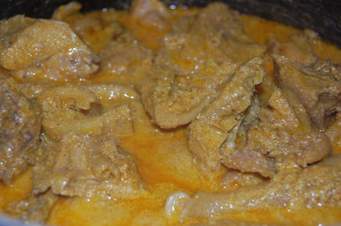



The choice of preparation of Melon soup commonly called “Egusi soup” is now desirable because it is becoming a welcome dish all over the world. This soup has become a delicacy at airports, sea ports, motor parks, railway stops and other places where people gather. This dish is being used at ceremonies like weddings, burials, naming, convocations, church activities, new yam festivals and get togethers.Due to the nutritious qualities and taste of the soup, many people love to eat it, but many do not know how to prepare it. Girls getting ready to marry should learn how to prepare this soup for their new husbands. Those who are old in marriage but do not know how to do so are encouraged to learn so that their marriages can have an added value. This is because women who satisfy the savor of their husbands build long lasting strength to their relationships.
This soup can be used to eat cooked rice, foofoo made out of maize, rice, guinea corn, plantains, cassava, and yams and so on. The preparation is as follows:
a. Purchases :
The following are the recipes for preparing Melon (Egusi) soup. The person preparing the soup buys the following from the market or supermarket; Desired quantity of melon, fresh meat or fresh fish, crayfish, fresh onions, dried stockfish, salt, fresh pepper, Palm oil, pumpkin leaves , seasoning agents and quantity of water.
Tools – pot, kitchen knife, blender, stove or gas cooker and plates
a. Preparation:
After purchasing the above mentioned items on the recipes list, the stock fish is soaked for about three hours to enable it loose. After that, the meat or fish and stock fish are parboiled with salt, seasoning and onions. The desired quantity of melon is blended and kept in a plate. Fresh onions are cut and put in a plate. Crayfish is blended and kept in a plate. The fresh pepper is blended and kept in a plate. The pumpkin leaves are washed with salt and cut into pieces.
b. The cooking :
The pot is placed on the stove or gas cooker. When it dries, desired quantity of palm oil is poured into the pot to steam. After three minutes, the following are added one after the other, desired quantity of salt, the cut onions, and seasoning are allowed to steam together, then the melon (Egusi ) is poured into the steaming pot. These are turned with kitchen spoon to mix properly. Small quantity of water is added to the stuff and then the parboiled meat, fish, stockfish; blended crayfish are allowed to boil for at least five minutes before putting the cut fluted pumpkin. The soup is turned and is ready to be served after three minutes boiling.
c. Serving:
Serve this soup with cooked rice, foofoo made out of maize, rice, guinea corn, plantains, cassava, wheat and yams. The Melon soup is full of proteins, vitamins and minerals needed for the body.
Nggak Nyangka! Hidup Gue Berubah Total! Gue bukan siapa-siapa. Cuma anak kos biasa yang kerja serabutan buat nutup biaya hidup… Read More
What is the Main Cause of a Heart Attack? What is its Solution? A heart attack is the blockage of… Read More
In the vast economic arena, one term that often takes center stage, inciting extensive debates and discussions, is the "debt… Read More
De-Dollarization: The Changing Face of Global Finance The financial landscape is in a state of flux, with an intriguing economic… Read More
The curtains closed on a dramatic Bundesliga season with Bayern Munich standing tall once again, clinching their 11th straight title.… Read More
The Unfolding Story of Celine Dion's Health In recent news that has left fans across the globe stunned, iconic singer… Read More
View Comments
This looks like a good recipe. I may have to give this one a shot. I am just wondering is this good to eat early morning or more of lunch or dinner type food?
It seems delicious and good to it since melon has a lot of health benefits. Jayaraman and Christina (2013) carried out a phytochemical analysis of the melon plant extracts. The study showed the presence of Cucurbitacin A, B, C, D, E (α-elaterin), saponins, alkaloids, anthranol, saponarin, tannins, tryptophan, terpenoids, J, L, caffeic acid, flavone glucosides, phenolic, arginine, flavanoids, cardic glycoloids, steroids, trace elements and sulfur-containing amino acids in this plant.
It is also an excellent source of nutritional minerals and vitamins such as carbohydrate, protein, fat, zinc, vitamin B1 (Thiamine), dietary fibre, sulphur, magnesium, vitamins B2 (Riboflavin), niacin and manganese.
Egusi is mostly grown for its shelled seeds that are usually ground and used for preparing assorted dishes such as egusi soup, egusi stew and salad. Some common Nigerian egusi dishes include; pounded yam and egusi soup, egusi and okro soup, Iyan and egusi, fufu and egusi soup, eba and egusi soup, egusi sauce and rice etc.
Before preparing the egusi soup or egusi sauce, the sun-dried seeds are either ground plain or roasted/fried before being ground. Chaffs obtained during the oil extraction of egusi seeds can be used for making fried cake snack popularly known as robo cake. The seeds can be fermented and used for making a local spice known as ogiri. Due to its high oil content, egusi seeds can be used for making margarine, butter and animal feed.